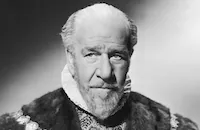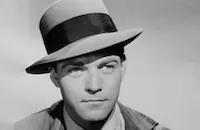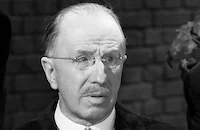Walking on Air

Brief Synopsis
Cast & Crew
Joseph Santley
Gene Raymond
Ann Sothern
Jessie Ralph
Henry Stephenson
George Meeker
Film Details
Technical Specs

Synopsis
When her father, the wealthy Horace Bennett, refuses to allow her to marry Fred Randolph and keeps her a virtual prisoner in her own mansion, Kit Bennett goes on a hunger strike in protest. Anxious to end Kit's questionable romance with the divorced Fred, Horace hires Joe, a bodyguard who has advertised himself in a newspaper's "situations wanted" column, to watch her. At the same time, Kit, seeing a similar ad for a "companion" of "noble character," gives in to her father's restrictions long enough to hire Joe's roommate, aspiring singer Pete Quinlan, to pose as an obnoxious, fortune-hunting French count in the hope that his behavior will make Fred look good by comparison. Pleased at Kit's apparent change of heart, Horace prepares lavishly for the "nobleman," even supplying him with a genuine French valet, Albert. As the count, Pete performs to perfection, insulting Horace and his spinster sister Evelyn at every turn. Just as they are about to evict the count, however, the Bennetts discover Pete's masquerade but, deducing Kit's scheme, pretend to like the count's ignoble character. Fred, meanwhile, sees that he is losing Kit to Pete and insists that he and Kit elope immediately. Sure that her father and aunt will be horrified, Kit announces her intention to marry the count, but is herself horrified when they respond with glee. Finally, Horace reveals his knowledge of the hoax and, while admitting that he likes Pete, encourages Kit to follow her heart. Now confused, Kit takes off to elope with Fred but, after nearly running over Pete, returns to claim him. He, however, has left the mansion and is performing on a radio program. After a mix-up concerning Pete's marital status is cleared up over the airwaves, Pete and Kit are finally united.

Director

Joseph Santley
Cast

Gene Raymond

Ann Sothern

Jessie Ralph

Henry Stephenson

George Meeker

Gordon Jones
Maxine Jennings

Alan Curtis
Anita Colby

Patricia Wilder
Frank Jenks

George Andre Beranger
Charles Coleman
A. S. Byron
Manny Harmon

Arthur Hoyt
Robert Graves
J. Maurice Sullivan
Jack Rice
Fred Stanley
Crew
Samuel J. Briskin
John L. Cass
Al Herman
George Hively
J. Roy Hunt
Rian James
Bert Kalmar
Bert Kalmar
Edward Kaufman
Bernard Newman
Van Nest Polglase
Harry Ruby
Harry Ruby
Nathaniel Shilkret
Viola Brothers Shore
Darrell Silvera
Sid Silvers
Vernon Walker

Film Details
Technical Specs

Articles
Walking on Air
Ann Sothern stars as Kit, the spoiled daughter of wealthy Horace Bennett. Kit wants to marry playboy Fred Randolph, but Horace believes Fred to be a fortune hunter so he refuses to allow his headstrong daughter to see him. Kit devises a plan to make Fred seem like the perfect candidate for marriage--a plan based on the key element of romantic comedy, which is masquerade. In the meantime, Pete Quinlan and his buddy, Joe, find themselves in need of jobs. While auditioning for a radio program, Pete meets Kit, who presents him with a proposition. She hires him to masquerade as a phony French nobleman named Count Pierre Louis de Marsac and to pretend to court her. The idea is for the Count to act so rude, obnoxious, and intolerable that Horace and his matronly sister, Evelyn, will actually prefer Fred. The casting of Sothern and Raymond dictates that their two characters end up together, so it doesn't take long before Pete and Kit fall in love. As in most romantic comedies, misunderstanding and misdirection will keep them apart until the final act.
During the 1930s, the use of romantic teams became a widespread casting strategy for studios. A successful pairing generated at least twice as much box office because it not only attracted fans of the team but also followers of the individual actors. Today's audiences are familiar with the most famous pairings, such as Astaire and Rogers, Tracy and Hepburn, or Powell and Loy, but dozens of other romantic teams were also part of the era. Sothern and Raymond lacked the chemistry and the stellar scripts of Hollywood's most famous romantic couples, but they were popular enough to appear in five films. The two were introduced as a pair in 1935 when Columbia lent Sothern to RKO for Hooray for Love. The following year, Sothern requested a release from her contract because she felt the roles she had been given lacked substance. She signed with RKO in the hopes of appearing in more challenging films, but the studio cast her in Walking on Air. Later that year, she was reteamed with Raymond for Smartest Girl in Town. In 1937, the pair made There Goes My Girl and She's Got Everything.
Publicity and promotion were generated to encourage newspapers, magazines, and fanzines to recognize Sothern and Raymond as a romantic team, and by 1938, their identity as a screen couple had been secured. A syndicated item in the Kerrville Mountain Sun (Texas) in February 1938 called them a "new team of motion picture sweethearts." A review of There Goes My Girl in the Beatrice Daily Sun (Nebraska) the following summer noted, "The two stars have won a notable following with their previous team vehicles." Raymond's version of the romantic lead played into his blond, wholesome good looks; he was courteous, thoughtful, and optimistic--a thoroughly likable, all-American guy next door. Sothern's chic, assured persona and her ability to toss out a snappy comeback complemented Raymond's unworldly, guileless characters.
Their teaming was short-lived, however, as Sothern, in her quest for better material, moved to MGM the very year her pairing with Raymond began to get so much publicity. In 1938, MGM cast her in Maisie, a comedy about a Brooklyn chorus girl that led to a new series of low-budget but entertaining films. In later years, Sothern lamented that she rarely escaped b-films, movie series, and light-hearted carefree roles, but, like other bona fide movie stars, she elevated the material through her screen persona and performance.
Sothern was correct in declaring that movies like Walking on Air lacked substantive content or any semblance of realism. Though the Depression loomed large in the collective consciousness, it does not figure at all into Walking on Air. Pete and Joe need jobs but do not suffer any of the consequences of unemployment, and both find means to make a living almost immediately. Nowhere are there references to breadlines, homeless veterans, or single women raising families. Van Nest Polglase's elegant, white set designs, including a deco-inspired night club with a nautical theme, are the opposite of the dark city streets of Warner Bros.'s gritty gangster flicks and melodramas.
The film's strengths--and even its purpose--have little to do with the content of the story. The intent was entertainment, primarily through performance. The focus is on the acting and singing skills of the cast, from the interplay between Raymond and Sothern to the songs by tunesmiths Harry Ruby and Bert Kalmar to the comedic talents of the supporting cast. Of the latter, character actress Jessie Ralph stands out as Kit's spinster aunt, Evelyn Bennett.
Ralph appeared in 55 films in her career, most of them between 1933 and 1941. She brought a lifetime of stage experience to Hollywood as well as the sagacity of someone who had seen great changes in American culture and society. She was born in 1864 during the Civil War, and she made her stage debut in a New England stock company in 1880, the year before the Gunfight at the O.K. Corral defined the Old West as wild. She appeared on Broadway for the first time in 1906, when women's rights advocate Susan B. Anthony died. As World War I raged in Europe, Ralph tried her hand at acting in silent films. But, the stage was her primary vocation. Throughout the 1910s and 1920s--arguably Broadway's finest era--she appeared in everything from Shakespeare to the musical comedies of George M. Cohan. Already in her 60s when she moved to Hollywood in 1933, she specialized in kindly grandmothers or society matrons. Among her most memorable roles were W.C. Fields's mother-in-law in The Bank Dick and Fairy Berylune in The Blue Bird (both 1940). Five years after her appearance in Walking on Air, Ralph's career ended after her leg was amputated.
In addition to her physical presence as an actress, Ralph knew her way around a good line. In Walking on Air, when Henry Stephenson as Horace Bennett excitedly explains to her that he has distributed books in French all over their house in honor of their guest, Count Pierre Louis de Marsac, Ralph cracks, "Good thing he is not Swiss, the house would be full of cheese."
It is easy to take a "frothy" little comedy like Walking on Air for granted, but fans of Golden Age movies know to look beyond the slight plot to uncover the film's hidden treasures.
--Susan Doll

Walking on Air
TCM Remembers - Ann Sothern
TCM Remembers - Ann Sothern
Quotes
Trivia
Notes
The working title of this film was Count Pete. Although Hollywood Reporter production charts include Harriet Hilliard in the cast, her participation in the final film is doubtful. RKO borrowed writer Viola Brothers Shore from Paramount for this production.














